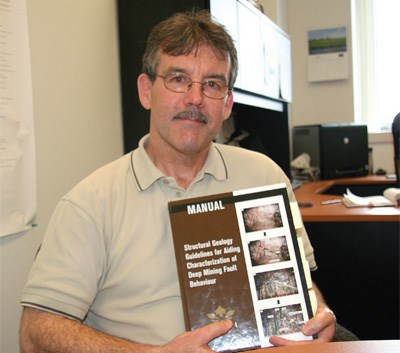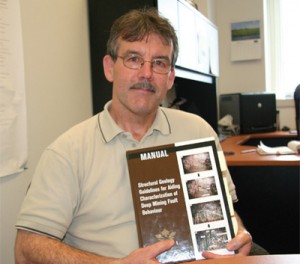Everything you ever wanted to know about faults and fractures has been condensed into one weighty tome published by the Sudbury-based Centre for Excellence in Mining Innovation (CEMI).
The 450-page book with the equally weighty title, “Structural Geology Guidelines for Aiding Characterization of Deep Mining Fault Behaviour,” started out as a report for local miners, Vale and Xstrata Nickel. “Initially, it was just going to be shared with them, but we saw there was value in it for the entire mining industry, so we asked them to open it up and they gave us their blessings,” said CEMI chief operating officer Damien Duff. “It’s a monumental piece of work.
“As we go deeper – particularly in our established mining camps – we face an immense number of challenges and the risks, likewise, are huge, so the need for these tools and guidelines is more pressing than ever.”
The book was written by Dr. Trevor Carter of Golder Associates with contributions by Duff, MIRARCO’s Benoit Valley, Golder’s Rob Bewick, Dr. Steve McKinnon of Queens University and graduate student Jessa Vatcher.
“Faults pose a risk for us because their behaviour can change as a result of the mining process itself,” explained Duff. “Ground may be static and in equilibrium, but as we go in and mine, we change the stress regime, and guess what? It’s no longer in equilibrium. It’s no longer static. It starts to behave dynamically.
“If we could understand how to predict the behaviour of these faults and structures better than we currently do, we’d be able to better manage the risks.”
The importance of better understanding rock behaviour is demonstrated by the suspension of mining operations at Agnico-Eagle’s Goldex Mine in Val d’Or, Quebec last October, and by the premature closing of Xstrata Nickel’s Montcalm Mine in March 2009.
Agnico-Eagle had to write off its $260 million investment in Goldex and reclassified 1.6 million ounces of proven and probable gold reserves as mineral resources.
“It’s very costly to have to walk away from all that value and lose all those jobs, so anything we can do to lessen the chance of failure is a good thing,” said Duff.
Knowledge transfer by way of a dense, 450-page tome is itself risky, so CEMI is now looking at converting it into a Wiki format.
“It’s a lovely book and everybody would like to have it, but by and large, they’re going to thumb through it and then they’re going to put it on their bookshelf,” said Duff. “We have to do better than that.
“Our intention over the next six to nine months is to improve an already valuable piece of work by using a social media-type tool. Once we’ve proven the concept, the goal would be to open it up to everybody.”
In April, CEMI hosted a half-day workshop on its fault-related research for approximately 70 mining engineers and geologists and, in October, it will host two multi-day short courses: one in Sudbury for Vale and Xstrata personnel, and one in Toronto that will be open to the industry as a whole.
Duff hopes that all of these efforts at knowledge transfer will help the industry design mines with ground support and drifts that are of an optimal size and orientation to accommodate the expected behaviour of structures and faults.




